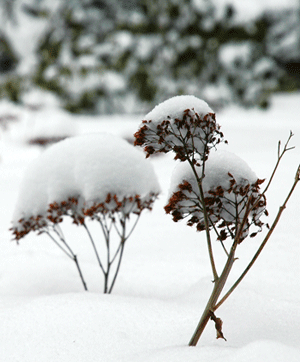It’s a Wrap: Winterizing Your Garden
Ruth Furman writer

As the year winds down so too does the frenzy of gardening chores, but the final tucking in of your garden is an important finishing step to protect your plants from the ravages of old man winter. The main culprits for plant loss over the winter are wind, freezing-thawing cycles, lack of moisture, and (surprise!) lack of snow cover. We can bundle ourselves up against the frigid temperatures or choose to stay indoors, but plants are out there exposed to all the extreme winter elements. Watering is not often a task we perform as the year draws to a close, but adequate moisture is vitally important, particularly for newly planted trees and shrubs. Just as we pour antifreeze into a car radiator to prevent freezing, bark, buds, and evergreen foliage produce an “antifreeze”- like fluid that inhibits ice crystals from forming. That’s why it is imperative to plant only material known to be hardy in our zone 6, as non-hardy species do not produce the necessary “antifreeze.” Without this, the plant’s cells will freeze, bursting the cell membrane, and ultimately causing tissue death. So, make sure your summer or autumn plantings continue to be well watered until the ground freezes.
The nor’easters that bombard our landscapes during the winter accelerate the process of evaporation. Once the ground freezes, replacing lost moisture becomes impossible, and a plant’s tissues become dehydrated or desiccated, with evergreens being particularly susceptible. Shelter from the prevailing winter wind can be provided by situating trees and shrubs alongside a structure like a shed, house, or fence. Taking the time to erect a temporary burlap screen is also a solution. Anti-desiccants can be sprayed on evergreens to inhibit dehydration and are readily available at your favorite garden center.
Those bright, sunny days of winter that lift our spirits can also inflict damage. The sun beams its rays towards plants warming up their tissues, but as the sun sets and the temperature plummets the plants are unable to respond quickly enough to the sudden drop. As a result, “antifreeze” isn’t produced fast enough and the cells freeze. The most susceptible area to this event, known as “sunscald,” is the trunk, and wrapping the trunk will moderate the problem.
While many of you may groan when winter’s white blanket is spread over the landscape, it is a great benefit to all the plants in your garden because snow provides a protective layer and some moisture on warmer days. No need to wait for snow though, as a simple covering of mulch – compost, shredded leaves, or pine needles—will protect your plants over the winter. But wait until the ground has frozen before laying down the mulch. Too soon and it will encourage small critters to take up residence under the mulch in the soft, warm soil and then, when hungry, they will dine on the nearest plants, gnawing the bark, and causing major damage. If the ground is frozen when mulching, they cannot burrow down into the soil. The mulch also alleviates frost heaves that occur as the temperature cycles through freezing and thawing. Freezing causes the soil to crack and lift up susceptible plants, especially perennials, exposing the roots to the frigid temperatures and an untimely death.
Before you begin preparing for the seasonal festivities take the time to cover or wrap your outdoor pals – they will thank you for this gift. ![]()
Happy Cultivating!
Ruth Furman is a Massachusetts Certified Horticulturist (MCH). She trained in horticulture in England and spent many happy years working and gardening there. To reach Ms. Furman, email her at: Ruth@wellesleywestonmagazine.com.
© 2011 Elm Bank Media | Beth Furman, Publisher | Beth@ElmBankMedia.com


recent comments